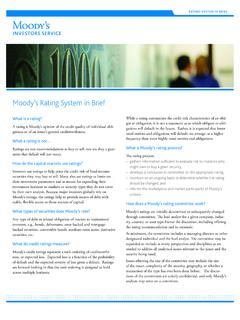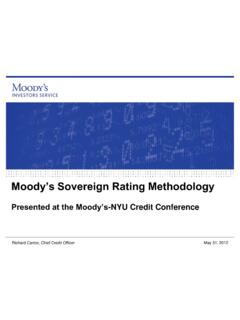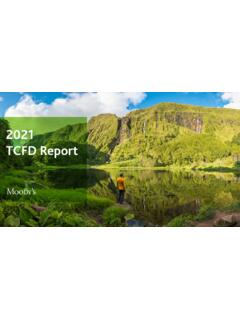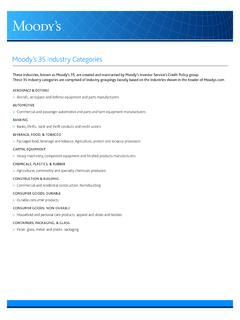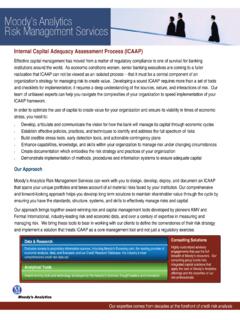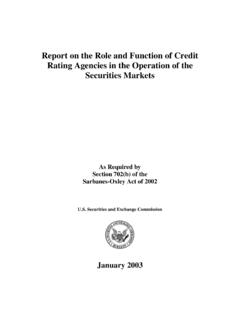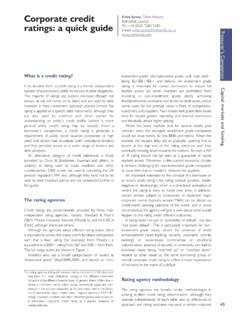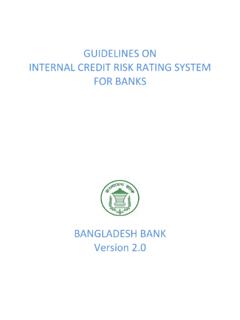Transcription of Moody's Credit Rating Prediction Model
1 Special CommentMoody's Credit Rating Prediction ModelAbstractThe Prediction of Credit ratings is of interest to many market participants. Portfolio risk managers often need to pre-dict Credit ratings for unrated issuers. Issuers may seek a preliminary estimate of what their Rating might be prior toentering the capital markets. For that matter, the Rating agencies themselves may seek objective benchmarks as an ini-tial input in the Rating paper suggests a new approach to predicting Credit ratings and evaluates its performance against conven-tional approaches, such as linear regression and ordered probit models. We find that by essentially every measure, thenew technology outperforms, often dramatically, these other models.
2 While this new approach is more complicated toestimate, it is not much more complicated to new Model has additional advantages in its interpretation as a structural ratings Model . Its output includesimplied ratings from each individual Credit metric and the appropriate weights to attach to those implied ratings ,which sometimes can be matters of interest themselves. This makes analysis and counterfactual testing nearly IntroductionCredit ratings are ordinal measures of through-the-cycle expected loss. As such, while they are certainly based on thecurrent financial strength of the issuer, they incorporate expectations of future performance as well - not just issuerperformance, but the industry and overall economy.
3 ratings also measure the relative permanence or stability of theissuer's financial position: fleeting or noisy disturbances, even those which might be reflected in bond spreads, do notimpact Credit ratings . Consequently, while we can hope to construct a "good" and "useful" mapping between conven-tional financial metrics and ratings , we know from the outset that we can never construct a perfect map, since we sim-ply cannot include all the factors which determine has not prevented the development of a variety of Rating Prediction models, both by academics and industrypractitioners. They generally fall into two types: linear regression and ordered probit.
4 Basic linear regression projectsratings (usually measured in linear or notch space, for instance with Aaa = 1 and C = 21) on various financial result is a linear index with fixed coefficients which maps directly to Rating space. The ordered probit (or logit)relaxes the assumption of a linear Rating scale by adding endogenously determined "break points" against which a sim-ilar fixed coefficient linear index is measured. For additional references on Rating models, please see Amato & Furfine(2004).New YorkAlbert Cantor ContactPhoneNovember 20062 Moody s Special CommentThese models have the advantages of easy computation and implementation, and both have been used they also have some drawbacks.
5 In the case of linear regression, one must make some purely arbitrary assignmentof a numerical value to an ordinal Rating category. Typically, as we said, one uses linear "notch space," but alternativelyone could use default rate space. Indeed, one could use anything monotonic. The ordered probit Model at least avoidsthis. But still, both models result in fixed coefficient linear indexes of the underlying factors, and that is something wewant to metrics need not - and generally do not - have constant importance in the ratings process. While we maysafely say that some measure of interest coverage is always considered, the relative importance of that metric may varywith the values of other metrics: for a highly leveraged issuer, interest coverage may be the most critical single factor,while for very low leveraged issuer, it may not be.
6 This kind of variability simply cannot be captured by any fixed-weight index subtle point which is sometimes overlooked in Rating Prediction models is that ratings are relative. At anypoint in time, we might observe a relationship between particular cardinal values of interest coverage and ratings , butwe should not expect that relationship to be stable over time. Instead, the distribution of ratings is fairly stable overtime, meaning the mapping between ratings and financials cannot be stable over time. It would be more correct to say"the best coverage ratio is associated with the best Rating " than to say "a coverage ratio of 5 is associated with a ratingof Aa1.
7 " To a certain extent this can be addressed by adding calendar time fixed-effects, essentially demeaning the dataevery year. But as other moments of the metric distributions may change, while the ratings distribution essentiallydoes not, the coefficients of the linear index cannot be correct over 1 compares the distribution of ratings in 2001 and 2005, and we see that it changes very slightly. However,from Figure 2 we can see that the distribution of coverage ratios,1 to take just one example, improves implication is that any mapping between values of coverage and ratings that may have obtained in 2001 would notobtain in Gaussian kernel 1 The Distribution of ratings is Stable Over Time02468101214 AaaAa1Aa2Aa3A1A2A3 Baa1 Baa2 Baa3Ba1Ba2Ba3B1B2B3 CShare of Issuers (in percent)20012005 Moody s Special Comment3 Finally, some thought must be given to the loss function underlying whatever Model is used.
8 In the case of linearregression, parameters are picked to minimize squared errors, thus putting much more weight on reducing large errorsthan small. But this does not correspond to how users of the Model perceive these tradeoffs. A least-squares criteriawould prefer a Model which had 18 issuers with one notch errors and one issuer with a nine notch error (total squarederrors being 99) to a Model which had 18 issuers with a zero notch error and one issuer with a 10 notch error (totalsquared errors being 100). But users of the Model would almost certainly prefer the latter, since, for all intents andpurposes, a nine notch error is every bit as bad as a ten notch error, but a zero notch error is much better than a onenotch this paper we present a methodology which addresses these drawbacks, and we show that its in- and out-of-sample performance is superior to these alternative models.
9 Simply stated, Credit ratings are assumed to be a weightedaverage of individual metric implied ratings , but the weights are not constant - they are functions of the issuer's lever-age ratio. Of course models are often used not just for Prediction , but for analysis and counterfactual might want to understand why a particular issuer obtains a particular Rating . One might want to ask what wouldhappen to the Rating if, ceteris paribus, interest coverage were to improve. Such tasks are really beyond any reducedform predictive Model , but the new Model proposed below has a structural interpretation which readily permitsanswering questions such as outline is as follows.
10 Section II describes the data, and Section III describes the new method and discusses itsstructural components. Section IV sketches a regression and ordered probit Model for comparison purposes, and inSection V compares their in-sample fit performance. Section IV sketches a regression and ordered probit Model forcomparison purposes, and Section V compares their in-sample fit a final note, our intention is not to replace or disparage other Rating Prediction models, since time has shownthat they are indeed simple and useful. Instead, we hope to suggest another, admittedly more ambitious, 2 The Distribution of Coverage Ratios Changes Over Time2. Indeed, the original motivation for developing this Model was precisely to address such questions.
